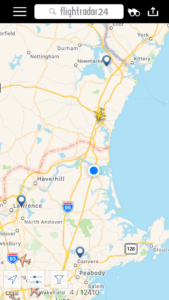The Best (and Worst) App of All Time

Flightradar 24 in map mode. You can see that a jet from London Heathrow headed for JFK in New York City is a few miles north of my location in Newburyport.
I’d be the first to acknowledge that the proliferation of so-called “smart phones” has been a major contributing factor in the decline of human civilization over the past couple of decades. Between the stupid games and the instant access to an infinite supply of useless information and the ever-expanding social media options — and occasionally, GASP!, the ability to actually communicate with other real, live people — having a supercomputer in your pocket has not created the Great Society some may have hoped for.
So it is with a mixture of pride and shame that I share with you an app I believe is absolutely awesome. Or the worst thing ever. Or, more likely, both.
It’s called Flightradar 24 and if you’re a geek, nerd, travel buff or just dig airplanes, you gotta have it. I think I paid $4.99 for it and while I am usually loath to pay for an app, I’m glad I paid for this one. There’s a free website of the same name (which is how I found the app) and it’s a good introduction to what the app is all about — a try-before-you-buy plan, so to speak.
What Flightradar does is combine your location and air-traffic data from all over the world. So when you see that airliner leaving a vapor trail overhead, you can find out what airline it is, where it’s coming from, where it’s going to, it’s altitude, speed, vertical speed, geographic location and more. It’s an aviation geek’s wet dream and while I’ve yet to actually orgasm, I have become slightly addicted to the damned thing.
And therein lies its negative attribute: once you start using it, you can’t stop. Whether you’re on the beach, out for a hike, in the city, on the golf course or anywhere else, inside or out, sunshine or rain, you’ll see or hear a plane going overhead and you can’t NOT pull out the app and see who it is. Sometimes ignorance CAN be bliss, but with Flightradar in your pocket, a vapor trail generates a hypnotically induced reaction: you reach into your pocket and pull out your phone because you…can’t. Help. It.

Here’s that same flight using the iPhone’s camera to find it by sight. This photo would be more impressive if it wasn’t overcast today.
On top of that, the compass and gyroscope-thingie in the iPhone (I can’t speak for how it works on non-Apple platforms) can determine where you are so when you set the app to visual mode, you can just point the camera at the plane and…voila! It’s too damned easy.
It really is mindless fun and useless information. But again, if you’re a plane geek, you’ll dig Flightradar. Living where I do — on the coast about 30 miles north of Boston — there are certain times of the day where an armada of jets from Europe passes overhead, and other times when that same armada is headed overseas. It’s cool to sit on my deck and watch the blinking navigation lights head out to sea and be able to know it’s an Aer Lingus flight headed for Shannon, Ireland, or a freight-carrying 747 headed for Luxembourg. At certain times of the day, depending the sun’s position in the sky, I can see the airline logos on the fuselage and tail with binoculars and match the plane up with the data in the app. (Like I said: it’s for geeks and nerds.)
Thus far, I’ve seen some pretty far out departure and destination cities. Sure, there ample flights to and from London, Paris and Zurich. But then there are the flights to and from Qatar, Moscow and Oslo; Tel Aviv, Milan and Istanbul; Beijing, Reykjavik and Madrid. Some of the more interesting (to me, anyway) flights I’ve seen have been from some Europe direct to Havana and Mexico City.
There’s one other problem with the app, in addition to being a serious attention-grabber and time-suck. Plenty’s the time I’ve seen a flight coursing above me, looked up the info on my phone and wished I’d been on the plane. Flightradar definitely adds to the wanderlust.

